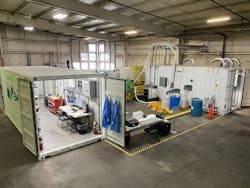In a recent interview with Revive Environmental President and CEO, David Trueba, and Director of Services & Marketing, Trevor Whitson, insights were shared on the challenges airports face with the discontinuation of fluorinated Aqueous Film-Forming Foams (AFFF). The interview shed light on the urgency for airports to transition to PFAS-free alternatives and the crucial role that responsible disposal plays in mitigating environmental risks.
The transition to PFAS-free alternatives is not merely a regulatory requirement but a crucial step toward safeguarding the environment, ensuring operational safety, and securing the future of aviation without compromising public health.
As airports grapple with the challenges of change, Trueba and Whitson provide solutions offering a responsible and sustainable path forward.
Airport Business: How has the discontinuation of fluorinated AFFF affected airports, and what are they using now?
Trevor Whitson: The airports, working alongside fire departments, have been grappling with the transition away from Aqueous Film-Forming Foams (AFFF). AFFF has been a crucial tool in quickly extinguishing fires, particularly those stemming from petroleum products like jet fuel, making it a staple at airports and military bases. The key mechanism involves the formation of a film, as indicated by its full name, which effectively smothers the fire.
However, the shift to alternative, fluorine-free foams (F3 foams) is prompted by the recognition of the dangers associated with Per- and Polyfluoroalkyl Substances (PFAS), a component found in high concentrations in AFFF.
The transition to F3 foams is not without challenges. The fundamental concept of rapid-fire suppression remains unchanged, so airports will need to make the change in a manner and time that meets their specific needs. Some entities are still using AFFF but are planning the transition, while others have already made the switch or adopted alternative methods that may not be as swift in fire suppression.
AB: Was there a specific timeframe required for airports to stop using fluorinated AFFF?
TW: In December 2022, Congress directed the FAA to develop a plan for airports to transition from AFFF to F3 foams. The FAA’s transition plan was released in May 2023 but does not specify a timeline. Regulations have been emerging through at the state and local level which restrict the use of AFFF and specific a timeline for transition to F3 foams.
The FAA’s plan specifies that in order to meet FAA Part 139 regulatory requirements, airports must use F3 foams which have met the Department of Defense’s (DOD) F3 foam military specification (MILSPEC F3) for use in aircraft situations and have been added to the Qualified Product List (QPL). This approval marks the ability for airports to shift to approved F3 foam, signifying that a viable and certified product was now available for implementation.
In August of 2023, one fluorine-free foam successfully passed the military specification tests, and was added to the QPL for use in aircraft situations. More F3 foams are undergoing testing to meet this specification.
AB: What was the sense of urgency among manufacturers with the impending cessation of production by major producers like National Foam and Tyco?
David Trueba: There was a notable sense of urgency across the board. While it wasn't a market frenzy, every operator felt the need to act swiftly. This urgency is crucial when considering the broader issue of PFAS and its human impact. The history of these products dates back 80 years to the Manhattan Project, where the efficacy of fluorine chemistry became evident. Society has extensively used fluorine in various applications, from food wrapping containers to airport foams. However, the human health implications were not seriously considered until the last 20 years, prompting a reevaluation of 80 years of use cases.
Public pressure on producers to halt or short-chain PFAS production has been building for almost two decades. In 2002, short-chain PFAS (also known as Gen X) was considered a replacement for long-chain PFAS. While the ban is now in place, it took 20 years for major producers to announce the cessation of production. The urgency stems from the announcement by National Foam and Tyco in July 2023, stating the cessation of current foams in aviation within 18 months, creating a critical need for replacement foam to maintain operational readiness. This urgency drives airports to expedite change-outs, ensuring a capable supply chain to stay operational.
AB: Can you elaborate on the challenges and considerations in transitioning to the new PFAS-free foams, both in terms of the foams themselves and the associated equipment at airports?
TW: Certainly. The AFFF foams have been crucial at airports and military bases for their ability to rapidly extinguish fires from petroleum products like jet fuel. The new PFAS-free foams aim to maintain the efficacy without the harmful fluorine contents. The transition faces challenges, primarily in ensuring that the new foams, while free of fluorine, can perform comparably. While the concept remains the same, there are definite challenges in terms of functionality and compatibility with existing equipment. Some continue using PFAS-based AFFFs while planning the transition, while others have already shifted to alternative methods, which might not be as quick in extinguishing certain types of fires. The FAA had advised airports to discontinue AFFF use about a year ago, but the transition was dependent on the approval of new foams. The Department of Defense plays a crucial role in this process, running an approval process with a qualified product list. The recent certification of one of the new PFAS-free products in August initiated the transition timeline for airports to adopt the alternative. It's essential to understand that the discontinuation of AFFFs wasn't enough; airports needed a certified substitute to ensure operational readiness.
According to the FAA’s transition plan, “MILSPEC F3s lack the fluorinated surfactant, and therefore do not have the film forming properties of AFFFs. As a result, MILSPEC F3s suppress the fire in only two ways: cooling it with water and suppressing vapors with the foam blanket.” The testing of F3 foams therefore has focused on rapid suppression – where possible being comparable to AFFF.
AB: What's driving the urgency for airports to transition to the new PFAS-free foams sooner rather than later?
DT: The primary driver is the imminent cessation of production by major foam producers like National Foam and Tyco. Their announcement last July, with a two-year timeline, means that by June 2025, there won't be replacement AFFF available for current users.
The critical aspect to consider is the requirement for airports, based on their size and traffic levels, to have a designated amount of foam in standby and another set aside for immediate use during events. This includes the need for an immediate replacement capability within the supply chain to maintain operational readiness. The impending unavailability of replacement AFFF is driving airports to expedite the transition to F3 foam alternatives, ensuring a continuous and reliable supply chain to meet their operational needs.
AB: The discontinuation of AFFF wasn't enough to solve airport issues due to contaminated groundwater. How are airports handling it, and how do you assist them?
DT: There are two main challenges. First, we help airports responsibly destroy unused AFFF foam, crucial for their operational transition…eliminating further contamination. Second, in dealing with PFAS-contaminated groundwater, we can partner with firms to extract the contaminated ground water and treat it using our PFAS Annihilator, aiding both disposal and remediation efforts.
AB: When you say, “responsibly destroy,” what does that mean?
DT: Disposing of any contaminant is a choice, involving cost and risk. Prior to Revive’s PFAS Annihilator, AFFF disposal options were limited to using a landfill, placing the PFAS material in a deep well, or storing it without disposal. In these options, the PFAS is not destroyed - it remains in the environment. Responsible destruction, in our view, is eliminating the PFAS from the water with laboratory verification. The PFAS Annihilator uses a process called Supercritical Water Oxidation (SCWO). This clean technology uses heat and pressure in a controlled reactor, breaking down the PFAS waste into carbon dioxide, salt, and clean water. We then use an EPA-certified lab to confirm the effluent is below environmental guidelines. This use of technology with lab verification is the basis of what we call confident responsibility in PFAS management.
TW: Our technology eliminates the PFAS from existence, removing the potential liability associated with PFAS disposal from those who generate the waste - in this case airport operators.
AB: What challenges are associated with contaminated groundwater cleanup?
DT: Any PFAS that has gotten into the ground needs to be cleaned up - guided by local, state, and federal guidelines. In the first half of 2024, the US EPA is going to designate certain PFAS molecules as hazardous. This designation guides the level of care and establishes requirements to treat the groundwater. When we talk to airports, they have two concerns: 1) “how do we remain operational during the transition to PFAS-free foams?”, and 2) “how do we dispose of the AFFF properly?”. Many airports consider groundwater remediation a long-term opportunity to solve, and transitioning the foam is first to ensure additional contamination does not occur.
Where do we help? Revive partners with companies that extract the groundwater from the contaminated sites, and that water goes through our PFAS Annihilator for disposal. This is similar to how AFFF foam is treated to result in PFAS-free water. Revive can help in both areas, with disposal of the concentrate and on the remediation side.
AB: What are the risks of not transitioning to PFAS-free alternatives, and how does Revive address these concerns?
TW: Not transitioning poses risks to safety and operations. Doing nothing results in potential liabilities and increased expenses, including when PFAS gets designated as hazardous. Revive addresses these concerns by providing responsible disposal and destruction methods, ensuring the environment is safeguarded.
AB: What is the key message for airports facing AFFF discontinuation?
DT: The urgency for seeking out responsible disposal solutions is something all airport operators will confront in the coming years. Revive Environmental stands as a partner, offering not only a means of disposal but also a commitment to responsible destruction, addressing environmental concerns and mitigating long-term liabilities.
AB: How crucial is the transition to PFAS-free alternatives for the aviation industry?
TW: The transition is not just a regulatory requirement; it's a crucial step toward safeguarding the environment, ensuring operational safety, and securing the future of aviation without compromising public health.





